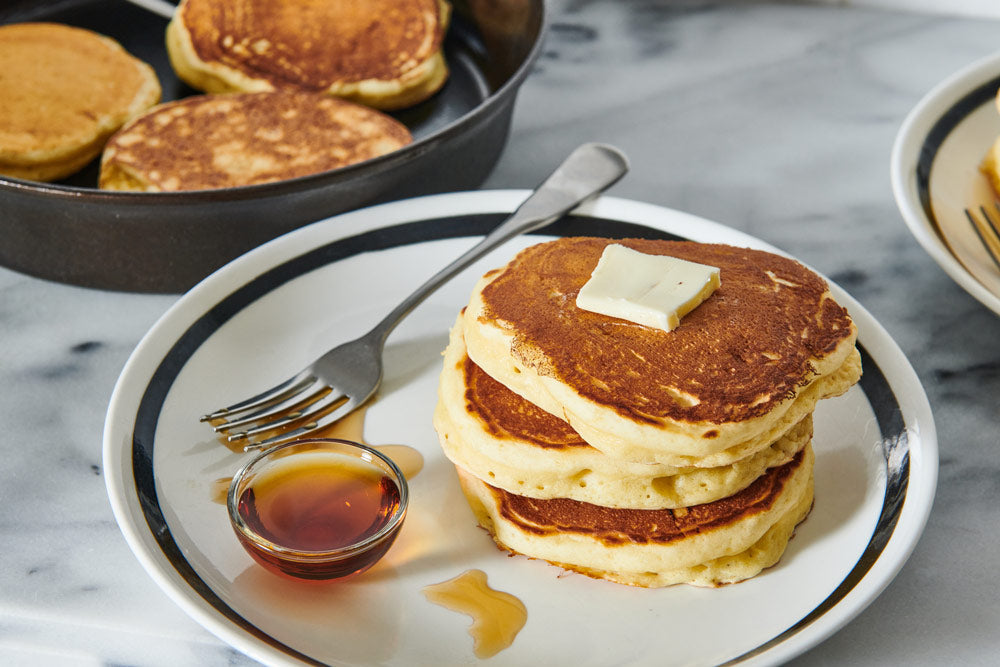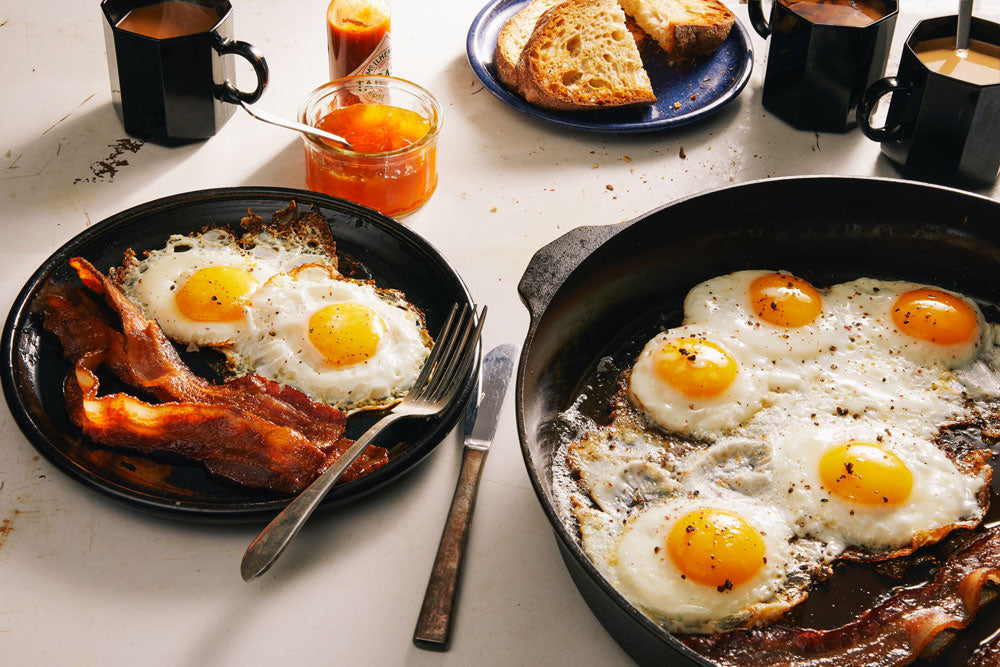
Table of Contents
- Is cast iron good for pancakes?
- Cast iron vs other cooking materials
- How to cook pancakes in cast iron?
- Recipe: Cast Iron Skillet Pancakes
- Tips and tricks for cast iron use
- How do you keep pancakes from sticking to cast iron?

When it comes to a cozy and satisfying breakfast, nothing beats a stack of fluffy homemade pancakes. You can achieve perfect pancakes quickly and easily, with our recipe for the best cast iron skillet pancakes, along with our top tips and tricks for cooking pancakes on cast iron. Ready, set, syrup!
Is cast iron good for pancakes?
One of the secrets to making amazing pancakes is having evenly distributed heat. This is a necessity for two reasons:
Pancakes have a short cooking time, so getting them to cook evenly throughout is essential—hot spots are the enemy!
In order to keep them fluffy, you only want to flip pancakes once. Having to flip a pancake more than once will undermine the efforts that went into your batter and preheating your pan.
Cast iron’s ability to retain heat makes it an ideal choice for pancakes. And cooking pancakes on cast iron gives them an incredible texture and golden brown color.

However, it’s essential to give your cast iron enough time to heat up thoroughly, so that the entire surface of the pan is evenly heated. Allowing time for heat to build up ensures it happens more uniformly and avoids hot spots, so you can be sure that regardless of where on the skillet you pour the batter, it will get cooked evenly.
When the time comes for the one (and only) flip, iron skillet pancakes are a safe bet thanks to the natural nonstick abilities of a well-seasoned cast iron pan. On top of that, your skillet is great at retaining a constant temperature, which equals fewer temperature adjustments and more consistent browning on your pancakes.
Cast iron vs. other cooking materials
When the mood to whip up a batch of pancakes strikes, you have a few pan materials to choose from. Each has its own benefits. Below, we’ve outlined the three most common choices and the differences between them.
Regardless of which option you choose, the best way to ensure your pancakes cook evenly (and don’t burn) is to preheat your pan properly and sacrifice a little batter for a test pancake to make sure the heat is just right.
Nonstick pans
A quality nonstick pan can help make pancakes super easy, giving you the peace of mind that when it comes time to flip them, your pancakes will release with ease. Most nonstick pans need very little fat for easy cooking, which means you might be able to skip oil or butter when frying your pancakes.
However, you may find yourself constantly adjusting the temperature as thinner nonstick pans release heat very quickly. Chemical-based nonstick coating is also fragile, and deteriorates over time.
Electric griddle
Easy to use and clean, an electric griddle with a nonstick surface will typically give you more even heat than a stovetop pan does. And if you’re cooking for a big family or group, choosing an electric griddle with a large cooking surface is a huge help allowing you to make more pancakes at the same time.
Cast Iron
Well-seasoned cast iron also provides a naturally nonstick surface with the added benefit that you don’t need to worry about harmful chemicals. Unlike other nonstick pans, the nonstick surface of a cast iron skillet is the result of the natural coating created when fats and oils are heated to the point that they reorganize and bond to the surface of the metal.

Cast iron is the best when it comes to even and consistent heat distribution. Heating up a cast iron skillet or griddle takes a little longer than an electric griddle, but a bit of patience goes a long way; cast iron simply makes the best pancakes.
How to cook pancakes in cast iron?
If you’ve been poking around online for tips on how to make pancakes on a cast iron skillet, you’ve likely seen rave reviews about pancake batter made with ingredients like sourdough starter and buttermilk.
We agree – cast iron sourdough pancakes are a tasty delight, and totally worth the effort when you’ve planned ahead and prepped specialty ingredients the night before.
However, for those mornings when you’re craving delicious pancakes but don’t have things like buttermilk on hand (probably most mornings), we’ve designed a quick and easy cast iron pancake recipe that’s an everyday winner and sure to satisfy!
Recipe: Easy Cast Iron Pancakes
Ingredients
2 cups all-purpose flour
2 teaspoons baking powder
½ teaspoon kosher salt
2 tablespoons sugar
2 large eggs
1½ cups milk, plus more as needed
1 teaspoon vanilla extract
2 tablespoons melted butter, cooled
Vegetable or coconut oil, for cooking
Tools
Resources
The Field Method for Cast Iron Care
Instructions
In a large mixing bowl, combine the flour, baking powder, salt, and sugar.
In another mixing bowl, beat the eggs, then whisk in the milk and vanilla extract. Stir in the melted butter.
Pour the liquid ingredients into the flour mixture and stir with a rubber spatula until combined (don’t overmix or the pancakes will be tough; a few lumps are fine). If the batter seems too thick, thin it out with a little more milk. Let the batter rest for 10 to 15 minutes (this allows the liquid to hydrate the flour, resulting in a fluffier pancake). At this point, the batter can also be refrigerated for up to 2 days.
Preheat a cast iron skillet over medium heat for about 5 minutes (we recommend a No.10 or No.12 Field Skillet, as the larger cooking surface allows for more pancakes to be made at once). Add a teaspoon or so of oil to your skillet (this helps get the pancakes a little crispy). Use a measuring cup or ladle to add ⅓ cupfuls of the batter to the skillet, spacing the pancakes out enough so they won’t touch as they cook.
Lower the heat to medium low and cook the pancakes until bubbles rise to the surface and the bottoms are golden brown, about 2 to 3 minutes. Flip and cook the other side, for 2 to 3 minutes longer. Lower the heat if the pancakes are browning too quickly.
Repeat with the remaining batter, adding a teaspoon of cooking oil with each batch of batter, and adjusting the heat as needed. Cooked pancakes can be kept warm on an oven-safe dish in a 200°F oven until ready to serve.
Serve warm with the toppings of your choice; we love these with sliced bananas and maple syrup.
Note: This batter can be made ahead and refrigerated for up to 2 days.
Tips and tricks for cast iron skillet pancakes:
Resist the urge to speed up the preheating process by using high heat; this will overheat your skillet and result in burnt pancakes. Don’t heat your skillet above medium, and you’ll want to turn it down to medium-low before you start pouring your cakes.
To check that the skillet is ready, sprinkle some water on the pan. If the water dances or bubbles a bit before evaporating, your pan is ready for use. If the water turns to steam immediately, the pan is too hot. Let it cool a bit and test again. Once your pan is ready to use, you may want to turn the temperature down slightly so that your pancakes don’t begin to burn.
To keep the pan evenly heated, use a skillet that is similar in size to the burner.
How do you keep pancakes from sticking to cast iron?
Preheating the skillet is necessary for both evenly cooked pancakes, and also ensures they don’t stick. It’s also essential that your pan is well seasoned. If it is, your pancakes should release with ease. If you find your pancakes are sticking, it’s probably time to re-season your pan; read more here to find out how.
Using a small amount of oil—just enough to thinly coat the surface of the pan—also helps ensure your pancakes don’t stick. Alternatively, you can opt for a recipe that has oil in the batter. The rule of thumb here is not to use too much oil, as it can create hotspots and prevent your pancakes from browning evenly.




